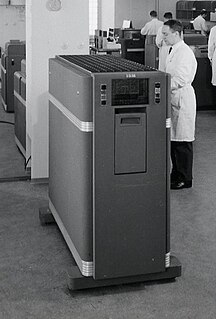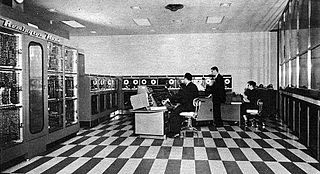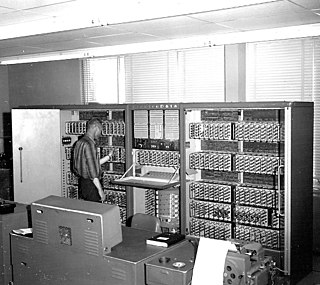Related Research Articles

The Burroughs Corporation was a major American manufacturer of business equipment. The company was founded in 1886 as the American Arithmometer Company. In 1986, it merged with Sperry UNIVAC to form Unisys. The company's history paralleled many of the major developments in computing. At its start, it produced mechanical adding machines, and later moved into programmable ledgers and then computers. It was one of the largest producers of mainframe computers in the world, also producing related equipment including typewriters and printers.

The IBM 604 Electronic Calculating Punch was the world's first mass-produced electronic calculator along with its predecessor the IBM 603. It was an electronic unit record machine that could perform multiple calculations, including division. It was invented and developed by Ralph Palmer, Jerrier Haddad and Byron Phelps. It was introduced by IBM in 1948.

UNIVAC was a line of electronic digital stored-program computers starting with the products of the Eckert–Mauchly Computer Corporation. Later the name was applied to a division of the Remington Rand company and successor organizations.

The IBM 701 Electronic Data Processing Machine, known as the Defense Calculator while in development, was IBM’s first commercial scientific computer and its first series production mainframe computer, which was announced to the public on May 21, 1952. It was invented and developed by Jerrier Haddad and Nathaniel Rochester based on the IAS machine at Princeton.

Sylvania's MOBIDIC, short for "MOBIle DIgital Computer", was a transistorized computer intended to store, sort and route information as one part of the United States Army's Fieldata concept. Fieldata aimed to automate the distribution of battlefield data in any form, ensuring the delivery of reports to the proper recipients regardless of the physical form they were sent or received. MOBIDIC was mounted in the trailer of a semi-trailer truck, while a second supplied power, allowing it to be moved about the battlefield. The Army referred to the system as the AN/MYK-1, or AN/MYK-2 for the dual-CPU version, Sylvania later offered a commercial version of the S 9400.

Starting at the end of the nineteenth century, well before the advent of electronic computers, data processing was performed using electromechanical machines collectively referred to as unit record equipment, electric accounting machines (EAM) or tabulating machines. Unit record machines came to be as ubiquitous in industry and government in the first two-thirds of the twentieth century as computers became in the last third. They allowed large volume, sophisticated data-processing tasks to be accomplished before electronic computers were invented and while they were still in their infancy. This data processing was accomplished by processing punched cards through various unit record machines in a carefully choreographed progression. This progression, or flow, from machine to machine was often planned and documented with detailed flowcharts that used standardized symbols for documents and the various machine functions. All but the earliest machines had high-speed mechanical feeders to process cards at rates from around 100 to 2,000 per minute, sensing punched holes with mechanical, electrical, or, later, optical sensors. The operation of many machines was directed by the use of a removable plugboard, control panel, or connection box. Initially all machines were manual or electromechanical. The first use of an electronic component was in 1937 when a photocell was used in a Social Security bill-feed machine. Electronic components were used on other machines beginning in the late 1940s.

The tabulating machine was an electromechanical machine designed to assist in summarizing information stored on punched cards. Invented by Herman Hollerith, the machine was developed to help process data for the 1890 U.S. Census. Later models were widely used for business applications such as accounting and inventory control. It spawned a class of machines, known as unit record equipment, and the data processing industry.
The BUNCH was the nickname for the group of mainframe computer competitors of IBM in the 1970s. The name is derived from the names of the five companies: Burroughs, UNIVAC, NCR, Control Data Corporation (CDC), and Honeywell. These companies were grouped together because the market share of IBM was much higher than all of its competitors put together.
Autocoder is any of a group of assemblers for a number of IBM computers of the 1950s and 1960s. The first Autocoders appear to have been the earliest assemblers to provide a macro facility.

Elliott Brothers (London) Ltd was an early computer company of the 1950s–60s in the United Kingdom. It traced its descent from a firm of instrument makers founded by William Elliott in London around 1804. The research laboratories were originally set up in 1946 at Borehamwood and the first Elliott 152 computer appeared in 1950.
Monroe Systems for Business is a provider of electric calculators, printers, and office accessories such as paper shredders to business clients. Originally known as the Monroe Calculating Machine Company, it was founded in 1912 by Jay Randolph Monroe as a maker of adding machines and calculators based on a machine designed by Frank Stephen Baldwin. It was later known as Monroe THE Calculator Company, and Monroe Division of Litton Industries.

A transistor computer, now often called a second-generation computer, is a computer which uses discrete transistors instead of vacuum tubes. The first generation of electronic computers used vacuum tubes, which generated large amounts of heat, were bulky and unreliable. A second-generation computer, through the late 1950s and 1960s featured circuit boards filled with individual transistors and magnetic core memory. These machines remained the mainstream design into the late 1960s, when integrated circuits started appearing and led to the third-generation computer.

The IBM Naval Ordnance Research Calculator (NORC) was a one-of-a-kind first-generation computer built by IBM for the United States Navy's Bureau of Ordnance. It went into service in December 1954 and was likely the most powerful computer at the time. The Naval Ordnance Research Calculator (NORC), was built at the Watson Scientific Computing Laboratory under the direction of Wallace Eckert.
The following outline is provided as an overview of and topical guide to computing:
Philco was one of the pioneers of transistorized computers. After the company developed the surface barrier transistor, which was much faster than previous point-contact types, it was awarded contracts for military and government computers. Commercialized derivatives of some of these designs became successful business and scientific computers. The TRANSAC Model S-1000 was released as a scientific computer. The TRANSAC S-2000 mainframe computer system was first produced in 1958, and a family of compatible machines, with increasing performance, was released over the next several years.

The Datatron is a family of decimal vacuum tube computers developed by ElectroData Corporation and first shipped in 1954. The Datatron was later marketed by Burroughs Corporation after Burroughs acquired ElectroData in 1956. The Burroughs models of this machine were still in use into the 1960s.
The Clary DE-60 was an early transistorized digital computer made by Clary Corporation. It was a compact (desk-sized) general-purpose computer intended for both scientific and business applications. It operated on 18-digit binary-coded decimal words used fixed-point arithmetic. Main memory was a 32-word magnetic drum memory. Input and output devices included a console keyboard, printer, paper tape and punched card system. For programming, the system used sequential instructions from the keyboard and plug-boards. Custom modules for trigonometric and other functions could be installed.
Samuel Lubkin (1906-1972) was a mathematician and computer scientist instrumental in the early history of computing.
References
- ↑ Turck, J.A.V. (1921). Origin of Modern calculating Machines. The Western Society of Engineers.
- 1 2 3 4 5 Cortada, James W (1993). Before the Computer; IBM, NCR, Burroughs & Remmington Rand & The Industry They Created 1865-1956 . Princeton University Press. pp. 158–162. ISBN 0-691-04807-X.
- ↑ Akera, Atsushi; Nebeker, Frederik (2002). From 0 to 1: An Authoritative History of Modern Computing. Oxford University Press. ISBN 0-19-514025-7.
- 1 2 3 4 5 6 7 8 Mecham, Alan D., ed. (1961). Data Processing Equipment Encyclopedia vol.1: Electromechanical Devices. Gille.
- 1 2 3 Mecham, Alan D., ed. (1961). Data Processing Equipment Encyclopedia vol.2: Electronic Devices. Gille.
- ↑ Burroughs E1400
- 1 2 3 4 5 6 7 Weik, Martin H. (1955). A Survey of Domestic Electronic Digital Computing Systems. Ballistic Research Laboratories.
- ↑ Fierheller, George A. (2006). Do Not Fold, Spindle or Mutilate: The 'Hole' Story of Punched Cards. Stewart. ISBN 1-894183-86-X.
- ↑ Weik, Martin H. (Mar 1961). "READIX". ed-thelen.org. A Third Survey of Domestic Electronic Digital Computing Systems.
- ↑ "10. READIX (J. B. Rea Company)". Digital Computer Newsletter. 8 (1): 6–9. Jan 1956.
- ↑ "READIX General Purpose Computer". ADP Equipment (Bull Machine Company Gamma 60; Philco Transac S-2000 Data Processing System Enclosed) Reports: 209–219 (543–553). 1 November 1957.
- ↑
- Encyclopedia of Espionage, Intelligence, and Security. Bukupedia. 2004. p. 76. ISBN 9780787675462.
- "NASIC's first computer". www.nasic.af.mil. 1958.
- "MISCELLANEOUS: 3. J. B. Rea Co., Santa Monica, Calif". Digital Computer Newsletter. 9 (2): 18–19. Apr 1957.
- ↑ "Elecom "50" advertisement | 102646271 | Computer History Museum". www.computerhistory.org. Retrieved 2018-05-31.
- ↑
- "15. Underwood Corporation". Digital Computer Newsletter. 7 (2): 10. Apr 1955.[ dead link ]
- Brown, Richard Hunt. (1955). "20. PRINCIPAL ELECTRONIC BUSINESS COMPUTERS. GENERAL DESCRIPTIONS, PICTURES AND PRICES". Underwood ELECOM 50 Computer. Office automation; integrated and electronic data processing. New York: Automation Consultants. p. 148. hdl:2027/mdp.39015021085249.
- John Diebold & Associates. (7 September 1956). The Use of Three Elecom 50s in a Small Service Bureau. Automatic data processing: Methods reports [and orientation]. Chicago: Cudahy Pub. Co. hdl:2027/mdp.39015021085397.
- ↑ "COMPUTERS, U. S. A.: 3. ELECOM, Underwood Corporation". Digital Computer Newsletter. 8 (2): 3–4. Apr 1956.[ dead link ]
- ↑ "NEWS RELEASES: Election Predictions by Electronic Computer" (PDF). Computers and Automation. 5 (12): 29. Dec 1956. Retrieved 2020-09-05.